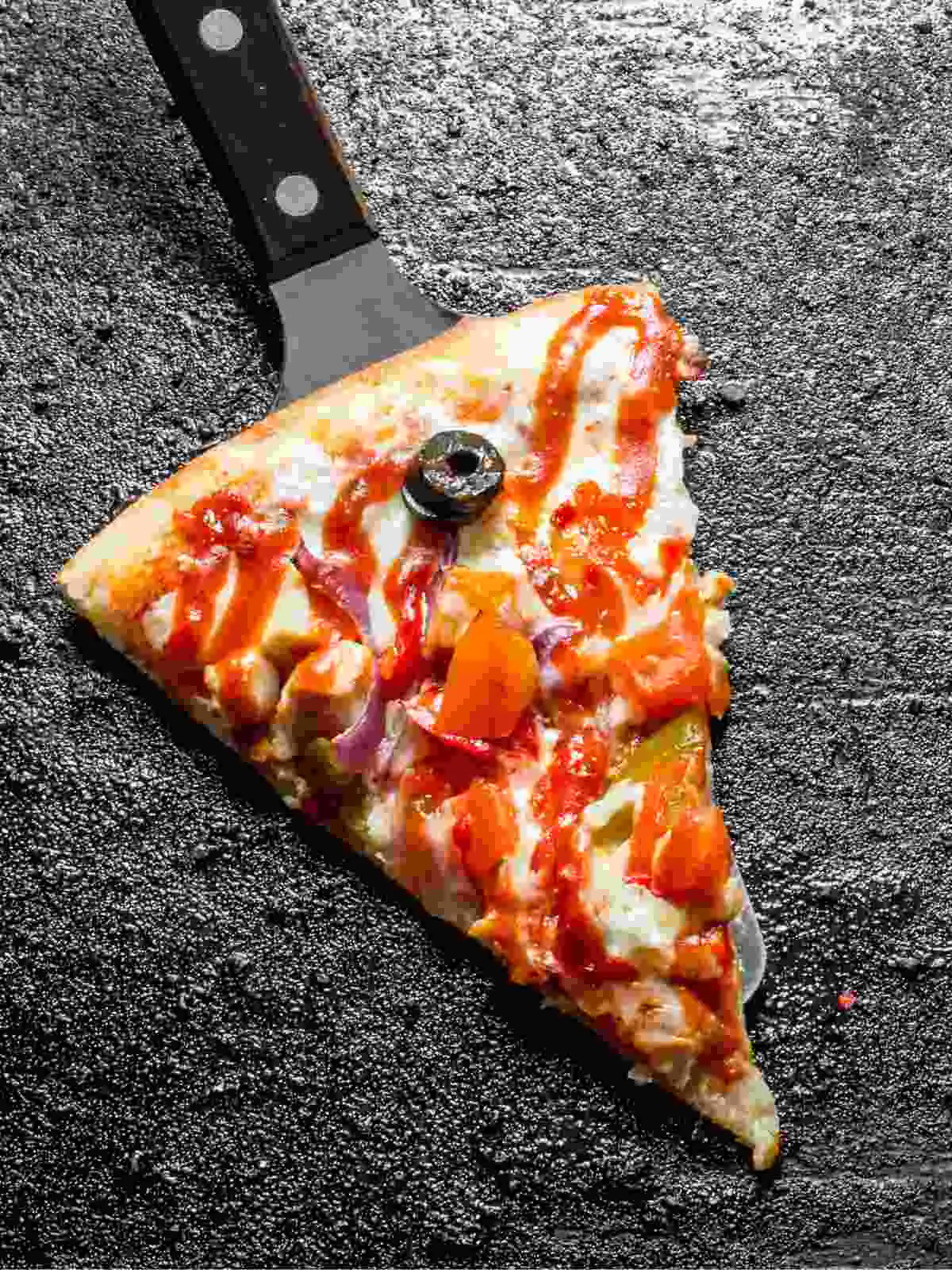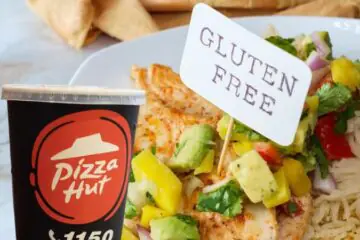There are approximately 285 calories per slice of pizza, on average. Pizza is a beloved food worldwide, with various toppings and flavors to satisfy almost anyone’s taste buds.
It’s hard to resist the delicious combination of melted cheese, savory sauce, and crispy crust. However, if you’re conscious about your calorie intake, you may wonder how many calories you consume with each slice. On average, a piece of pizza contains around 285 calories.
Remember that this number can vary depending on the type of crust, toppings, and slice size. We’ll explore the calorie content of different kinds of pizza and provide tips on making healthier choices without sacrificing the taste. So, whether you’re a fan of classic pepperoni or prefer veggie-loaded options, read on to learn more about the calorie content of your favorite pizza slices.
Understanding The Calorie Content Of Different Pizza Types
With its irresistible combination of cheese, sauce, and toppings, pizza is a beloved indulgence for many. However, if you are conscious of your calorie intake, it’s essential to understand how many calories each slice of pizza contains. In this blog post, we will delve into the calorie content of different pizza types, analyzing popular pizza types, crust options, and cheese varieties to help you make informed decisions about your pizza choices.
Popular Pizza Types And Their Average Calorie Range
Knowing the average calorie range of popular pizza types can assist you in making smarter choices when ordering pizza. Let’s take a closer look:
| Pizza TypeAverage Calorie Range per Slice | |
|---|---|
| Pepperoni | 250-350 calories |
| Margherita | 200-300 calories |
| Hawaiian | 250-350 calories |
| Vegetarian | 200-300 calories |
| Meat Lover’s | 300-400 calories |
These figures are approximate and can vary depending on the size of the slice and the preparation method. Still, they provide a general idea of the calorie content you can expect from popular pizza types.
Analyzing Crust Options And Their Impact On Calorie Count
The type of crust you choose can significantly impact the calorie count of your pizza. Let’s explore some standard crust options:
- Thin Crust: Thin and crispy, this crust typically has the lowest calorie count, ranging from 100-150 calories per slice.
- Thick Crust: Known for its doughy texture, thick crust pizzas can range from 200-300 calories per slice due to the additional dough used.
- Stuffed Crust: With its gooey cheese filling, stuffed crust pizzas can add 50-100 extra calories to each slice.
- Gluten-Free Crust: A gluten-free crust can range from 150-200 calories per slice
for gluten sensitivities.
You can enjoy your pizza without overindulging in unnecessary calories by choosing a crust option that aligns with your dietary goals.
Delving Into Cheese Varieties And Their Calorie Implications
When it comes to cheese, different varieties can have varying calorie implications. Let’s take a look at a few standard options:
- Mozzarella: The most commonly used cheese on pizzas, mozzarella typically adds around 70-80 calories per slice.
- Cheddar: Known for its sharp flavor, it can contribute roughly 80-90 calories per slice.
- Goat Cheese: Creamy and tangy goat cheese can add around 60-70 calories per slice.
- Plant-Based Cheese: Plant-based cheese options can range from 50-100 calories per slice for those following a vegan or plant-based diet.
By being aware of the calorie content of different cheese varieties, you can select the one that aligns with your preferences and dietary needs.
Understanding the calorie content of different pizza types, crust options, and cheese varieties empowers you to make informed choices that suit your dietary goals. Whether you prefer a thin-crust veggie pizza or a thick-crust meat lover’s delight, knowing the calorie implications allows you to indulge in moderation while savoring every bite.
:max_bytes(150000):strip_icc()/turkey-sandwich-09f5e7ad540f4f28994e80bdd9af05db.jpg)
Credit: www.verywellfit.com
Toppings: The Hidden Caloric Culprits
Toppings: The Hidden Caloric Culprits
When it comes to indulging in a slice of pizza, we often focus on the calorie count of the crust and the type of cheese used. However, we often overlook the toppings – the sneaky accomplices that can add extra calories to our favorite treat. This section will delve into the world of pizza toppings and uncover their true calorie impact. Get ready to be surprised!
Investigating The Calorie Impact Of Meat Toppings
Meat lovers rejoice, for your favorite pizza toppings may come at a cost when counting calories. Let’s take a look at the calorie content of some popular meat toppings:
| Topping | Calories per slice |
|---|---|
| Pepperoni | Approximately 60-70 calories |
| Sausage | Around 120-140 calories |
| Bacon | About 35-45 calories |
These meat toppings can add a significant amount of calories to your slice of pizza. Choosing leaner options or less meat can help keep the calorie count in check.
Unveiling The Truth About Vegetable Toppings And Their Calorie Content
Vegetable toppings are the obvious choice for those looking for a lighter pizza option. Fresh veggies add flavor and nutrients to your pizza but can still contribute to the calorie count. Let’s explore the calorie content of standard vegetable pizza toppings:
- Mushrooms: Approximately 5-10 calories per slice
- Onions: Around 10-15 calories per slice
- Green peppers: About 5-10 calories per slice
- Olives: Approximately 10-15 calories per slice
- Spinach: Around 5-10 calories per slice
While these numbers may seem small, they can add up if you pile on multiple vegetable toppings. When building your pizza, consider portion sizes and the overall calorie count.
Analyzing The Calorie Differences Between Traditional And Gourmet Toppings
Traditional toppings like pepperoni and sausage are often crowd favorites, but gourmet toppings have been gaining popularity in pizza. But are gourmet options healthier in terms of calories? Let’s compare the calorie content of traditional and gourmet toppings in the table below:
| Topping | Calories per slice (traditional) | Calories per slice (gourmet) |
|---|---|---|
| Mushrooms | Approximately 5-10 calories | Approximately 10-15 calories |
| Pepperoni | Approximately 60-70 calories | Approximately 70-80 calories |
| Arugula | About 5-10 calories | About 10-15 calories |
| Prosciutto | Approximately 60-70 calories | Approximately 70-80 calories |
As you can see, the calorie differences between traditional and gourmet toppings are relatively minor. It ultimately comes down to personal preference and the types of ingredients you enjoy. Remember to watch portion sizes and balance your choices to keep your pizza delicious and nutritious.
Sizing Up The Slice: Portion Control And Calorie Awareness
Examining The Significance Of Slice Size On Calorie Intake
When it comes to enjoying a delicious slice of pizza, portion control, and calorie awareness play a crucial role in maintaining a healthy diet. The piece’s size directly impacts the number of calories consumed, making it essential to understand just how significant slice size can be.
How To Estimate Calories For A Slice Based On Size
Estimating the calorie content of a pizza slice based on its size, can help you make informed choices about your diet. Here are some general guidelines to keep in mind:
- Start by finding the nutrition information for the entire pizza, including the total number of calories. This information is typically available on the pizza box or the restaurant’s website.
- Next, determine the number of slices in the pizza. Divide the number of calories by the number of pieces to get the average calorie count per slice.
- Finally, consider the size of the slice. Adjust the calorie count accordingly if the cut is larger or smaller than average. For example, a more significant piece may contain more calories, while a smaller slice may contain fewer.
By estimating calories based on slice size, you can make more accurate decisions about your pizza consumption, allowing you to enjoy your favorite treat without throwing your calorie intake off balance.
Tips For Practicing Portion Control Without Sacrificing Enjoyment
Practicing portion control doesn’t mean sacrificing the enjoyment of eating pizza. Here are some tips to help you strike a balance between savoring your slice and watching your calorie intake:
- Choose thin-crust pizzas over deep-dish or stuffed-crust options. Thin-crust pizzas generally have fewer calories per slice.
- Think about splitting a pie with someone you care about. Breaking the calories between multiple people can help reduce your intake.
- Add a salad or veggie dish to your pizza for a healthy meal. This can help fill you with lower-calorie options while allowing you to enjoy a slice or two.
- Opt for healthier toppings such as vegetables, lean meats, and herbs. These choices can add flavor and nutrients to your pizza without significantly increasing calorie content.
- Mindful eating is critical. Enjoy your food more by eating slowly and noticing signs of fullness. This can prevent overeating and allow you to enjoy your meal fully.
By practicing portion control and making conscious choices regarding slice size, you can still indulge in the deliciousness of pizza while maintaining a healthy balance in your diet. So go ahead, savor each bite guilt-free!
The Quest For Healthier Pizza: Low-calorie Alternatives
The quest for healthier pizza has become a top priority for many calorie-conscious individuals. With pizza being a beloved comfort food enjoyed by millions worldwide, finding low-calorie alternatives has become essential in maintaining a balanced diet. Fortunately, there are several ways to transform this indulgent treat into a guilt-free option without compromising taste. Let’s explore healthier crust options, compare alternative cheese choices, and discover innovative ways to reduce calorie content through creative toppings.
Exploring Healthier Crust Options For Calorie-conscious Individuals
When it comes to pizza, the crust plays a significant role in its calorie content. Traditional pizza crust is typically made from refined flour, producing a higher calorie count. However, various healthier crust alternatives are available to satisfy your pizza cravings without derailing your diet.
Here are some options to consider:
- Cauliflower Crust: Made from grated cauliflower, this gluten-free and low-carb crust substitute is becoming increasingly popular. It offers a light and crispy texture, making it an excellent choice for those watching their calorie intake.
- Whole Wheat Crust: Opting for whole wheat crust provides added nutritional benefits by incorporating fiber and nutrients into your pizza. Not only does it reduce the calorie count, but it also offers a heartier taste.
- Thin Crust: Thin crust pizzas naturally contain fewer calories than thicker crusts due to reduced dough volume. This option allows you to enjoy pizza while keeping your calorie intake in check.
Comparing Alternative Cheese Options And Their Calorie Benefits
Cheese is undeniably a quintessential element of any pizza. However, it is often a significant contributor to its calorie content. Thankfully, alternative cheese options can significantly reduce the calorie count without compromising on flavor.
Consider the following low-calorie cheese options:
| Cheese Option | Calorie Content per Serving |
|---|---|
| Part-Skim Mozzarella | 70 calories |
| Reduced-Fat Cheddar | 80 calories |
| Goat Cheese | 60 calories |
By choosing these alternatives, you can still enjoy the creamy goodness of cheese while keeping your pizza’s calorie count in check.
Discovering Innovative Ways To Reduce Calorie Content Through Creative Toppings
Alongside crust and cheese choices, the selection of toppings offers an opportunity to reduce calorie content further while adding a burst of flavor to your pizza.
Consider these creative and low-calorie topping options:
- Load up on a colorful assortment of vegetables such as spinach, bell peppers, mushrooms, and tomatoes. These fiber-rich additions enhance the nutritional value of your pizza and help keep the calorie count low.
- Opt for lean protein toppings like grilled chicken or turkey sausage, avoiding the excessive saturated fats in traditional meat options like pepperoni or sausage.
- Experiment with unique flavor combinations by adding herbs, spices, and seasonings. This way, you can enhance the taste without using high-calorie sauces or excessive amounts of salt.
By innovating with toppings, you can create a healthier and customized pizza while maintaining a low-calorie profile.
Making Informed Choices: Navigating Pizza Restaurants And Caloric Transparency
When it comes to enjoying a slice of pizza, it’s no secret that it’s a crowd favorite. However, navigating pizza restaurants and their caloric transparency can be tricky for those who are conscious of their calorie intake. Understanding how many calories are in each slice of pizza and how to make informed choices is crucial. In this blog post, we’ll explore the role of pizzerias in providing calorie information, understand menu labeling regulations, and share some tips for deciphering nutrition information to make healthier pizza choices.
Exploring The Role Of Pizzerias In Providing Calorie Information
Pizzerias have a significant role in providing calorie information to their customers.
While not all pizzerias may actively disclose calorie information, it’s becoming increasingly common for establishments to include this information on their menus. Doing so enables customers to make more informed choices about what they order.
Whether it’s through listing calorie counts next to each pizza option or on a separate menu section, pizzerias can empower individuals to understand better their choices’ impact on their overall calorie intake.
Understanding Menu Labeling Regulations And Their Impact On Consumer Choices
Menu labeling regulations are essential for ensuring that consumers have access to accurate and comparable nutrition information. These regulations often require pizzerias and other food establishments to disclose calorie information on their menus.
Pizzerias can help consumers make healthier choices by adhering to these regulations by providing transparent information. This information allows customers to compare options and choose pizzas that align with their dietary preferences and goals.
Tips For Deciphering Nutrition Information And Making Healthier Pizza Choices
Deciphering nutrition information at a pizza restaurant can be overwhelming, but with these tips, you can make healthier choices without sacrificing taste:
- Pay attention to serving sizes: The listed information is often based on specific serving sizes. It’s crucial to take this into account when assessing the calorie content.
- Choose thin crust options: Opting for thin crust pizzas can significantly lower the calorie content compared to thick crust or deep-dish alternatives.
- Load up on veggies: Incorporating vegetables as toppings can add flavor and nutritional value without excessive calories.
- Consider portion control: If you’re in the mood for a higher-calorie pizza, try sharing it with a friend or saving half for later to manage your calorie intake.
Remember, making healthier pizza choices doesn’t mean giving up on flavor. It’s all about finding the right balance that suits your preferences and goals. By being aware of the calorie information provided by pizzerias and using these tips to decipher and make choices, you can enjoy your favorite slice guilt-free.
Frequently Asked Questions On How Many Calories Per Slice Of Pizza
A slice of pizza typically contains around 285-350 calories, depending on the toppings and size. The crust, cheese, and toppings contribute to the calorie content, so it’s essential to be mindful of portion sizes when enjoying this delicious treat.
To reduce the calorie content of your pizza, you can opt for a thin crust instead of a thick one, choose vegetable toppings instead of fatty meats, and go light on the cheese. Another option is to make your pizza at home, where you can control the ingredients and portion sizes.
Yes, there are several healthier pizza options available. You can choose a pizza with a whole wheat crust, which adds more fiber to your meal. Additionally, opting for vegetable toppings like spinach, tomatoes, and bell peppers can increase the nutritional value of your pizza while keeping the calorie count in check.
Conclusion
It’s essential to be mindful of the number of calories in a slice of pizza, as it can vary greatly depending on the toppings and size. By being aware of the calorie content, you can make more informed choices and enjoy pizza in moderation as part of a balanced diet.
Remember, balance is critical when indulging in everyone’s favorite cheesy delight! So savor your slice and stay on track with your health goals.

As the author of the “Ultimate Pizza Guide: Recipes, Tips & Secrets Revealed,” I’m dedicated to sharing my love for pizza and empowering others to create delicious homemade pizzas with ease. Join me on a journey to uncover the secrets to perfecting your pizza game!



